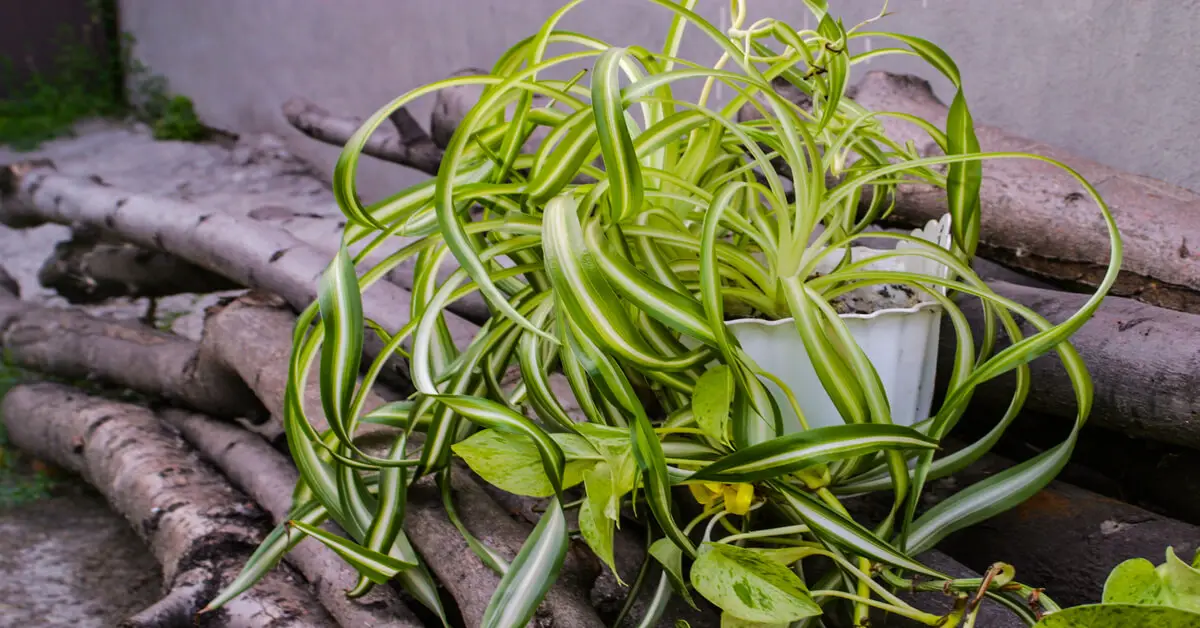Embark on a captivating journey into the world of curly leaf spider plants, where intricate details and scientific insights intertwine to paint a vibrant tapestry of knowledge. Their distinctive appearance, meticulous care requirements, and diverse applications make them a fascinating subject for exploration.
With their captivating foliage and remarkable resilience, curly leaf spider plants have captivated plant enthusiasts worldwide. Join us as we delve into their characteristics, unravel their secrets, and uncover the captivating world that surrounds these extraordinary botanical wonders.
Characteristics and Identification: Curly Leaf Spider Plant

Curly leaf spider plants, scientifically known as Chlorophytum comosum ‘Curly’, are a captivating species of flowering plants belonging to the Asparagaceae family. Their distinctive appearance and adaptability make them popular choices for both indoor and outdoor cultivation.
These plants typically range in height from 6 to 12 inches, with a spread of 12 to 18 inches. They exhibit a compact, rosette-like growth habit, with arching, lance-shaped leaves that cascade gracefully from the central point. The leaves are their most notable feature, showcasing a vibrant green hue with striking, spiraling curls that add a touch of elegance to any space.
Leaf Characteristics
The leaves of curly leaf spider plants possess a unique texture, feeling smooth and pliable to the touch. Their shape is typically elongated and pointed, with a slightly wavy or ruffled margin. The prominent curls or spirals that adorn the leaves are a defining characteristic of this species, giving them their distinctive appearance. These curls are formed due to a genetic mutation that affects the plant’s growth pattern, resulting in the leaves twisting and curling as they emerge from the central rosette.
Distinctive Features
Curly leaf spider plants can be distinguished from other similar species by several key features. Firstly, the spiraling curls on their leaves are a unique trait that sets them apart. Additionally, the leaves of curly leaf spider plants tend to be narrower and more pointed compared to other spider plant varieties. Furthermore, they have a more compact growth habit, forming a dense, rosette-like clump rather than the sprawling growth pattern seen in some other spider plant species.
Care and Maintenance

Curly leaf spider plants are relatively easy to care for, but providing them with the right conditions will help them thrive and produce abundant foliage. Here are some key considerations for their care and maintenance:
Light Requirements
Curly leaf spider plants prefer bright, indirect light. They can tolerate low light conditions, but their growth will be slower and they may not produce as many leaves. Avoid placing them in direct sunlight, as this can scorch their leaves.
Temperature Requirements
Curly leaf spider plants prefer warm temperatures between 65-80°F (18-27°C). They can tolerate slightly cooler temperatures, but they may go dormant if the temperature drops below 55°F (13°C).
Humidity Requirements, Curly leaf spider plant
Curly leaf spider plants prefer moderate to high humidity. They can tolerate average humidity levels, but they will appreciate a humidifier or regular misting, especially during dry winter months.
Watering
Water curly leaf spider plants when the top inch of soil feels dry to the touch. Allow the excess water to drain out of the bottom of the pot. Overwatering can lead to root rot, so it’s important to let the soil dry out slightly between waterings.
Fertilizing
Fertilize curly leaf spider plants monthly during the growing season (spring and summer) with a balanced liquid fertilizer. Dilute the fertilizer to half strength and apply it to the soil.
Pruning
Curly leaf spider plants do not require regular pruning, but you can trim off any dead or damaged leaves as needed. You can also trim back the plant if it becomes too leggy or overgrown.
Pest Control
Curly leaf spider plants are generally pest-free, but they can be susceptible to mealybugs and spider mites. If you notice any pests, treat the plant with an insecticidal soap or neem oil.
Propagation and Uses

Curly leaf spider plants are easy to propagate, making them a popular choice for gardeners. There are several methods for propagating these plants, including division, cuttings, and offsets.
Division
Division is the simplest method of propagating curly leaf spider plants. To divide a plant, carefully remove it from its pot and gently separate the roots into two or more sections. Each section should have at least three to four leaves. Plant the divisions in individual pots filled with a well-draining potting mix.
Cuttings
Curly leaf spider plants can also be propagated from cuttings. To take a cutting, use a sharp knife or scissors to cut a 4- to 6-inch stem from a healthy plant. Remove the lower leaves from the cutting and dip the end in rooting hormone. Plant the cutting in a pot filled with a well-draining potting mix. Keep the cutting moist and in a warm, sunny location.
Offsets
Curly leaf spider plants often produce offsets, which are small plants that grow from the base of the main plant. Offsets can be removed and planted in their own pots to create new plants. To remove an offset, carefully dig around the base of the plant and gently pull it away from the main plant. Plant the offset in a pot filled with a well-draining potting mix.
Uses
Curly leaf spider plants are popular ornamental plants. They are often used in hanging baskets or as a groundcover. The plants are also known for their air-purifying abilities. They can remove toxins from the air, including formaldehyde, benzene, and trichloroethylene.
In addition to their ornamental and air-purifying properties, curly leaf spider plants also have some medicinal properties. The leaves of the plant can be used to make a tea that has been used to treat a variety of ailments, including coughs, colds, and sore throats.